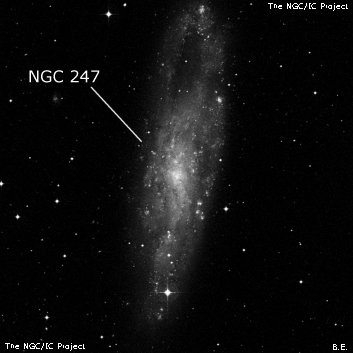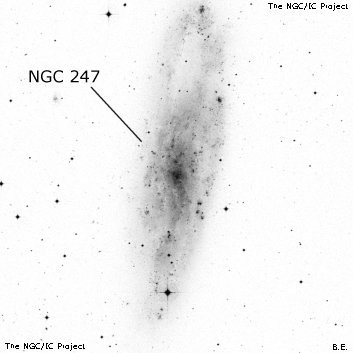NGC/IC Project Restoration Effort
(This is a very very beta version)
NGC247


Basic Information
Location and Magnitude
Right Ascension: 0:47:8.3
Declination: -20:45:36
Constellation: CET
Visual Magnitude: 9.1
Historic Information
Discoverer: Herschel W.
Year of discovery: 1784
Discovery aperture: 18.7
Observational
Summary description: F, eL, vm E 172°
Sub-type: SBcd
Corwin's Notes
=====
NGC 247. While there is no mistaking this large galaxy -- one of the nearest
in our sky -- the position I've chosen still carries a whiff of doubt in my
mind. Is the object at that position the stellar nucleus, or is it a
superposed star? Concensus at the moment (December 2013), from various notes
and abstracts in NED, suggests it is indeed the nucleus. But I was unable to
dig out a spectrum of the object to be sure. Even if it is a star, though, it
is still a good proxy for the galaxy.
Steve's Notes
=====
NGC 247
48" (10/31/13): at 287x, NGC 247 spanned at least 18'x5' NNW-SSE, stretching from an HII region at the NNW tip to beyond a mag 9.5 star near the SSE end. An interesting feature is a very large, elongated darker (dusty) region dubbed the "Needle's Eye" on the NNW side, extending at least 3.5'x1.0'. A relatively bright HII knot (identified in NED as MRSS 540-038059 from the "Muenster Red Sky Survey") is beyond this feature, 9.5' NNW of center. It appeared fairly faint, relatively large for an HII region, elongated ~N-S, 20"x12". A second well-defined HII knot is MRSS 540-038506, found 5' NNW of center. This easy patch appeared fairly faint, elongated, 15"x10". At least two small knots (including MRSS 540-038001) are on the SW side of the halo ~2.4' from center and ~1.5' E of a mag 12-12.5 star just off the west edge of the disc. Finally, I picked up a faint, very small knot, ~6" diameter, situated 3.5' SSE of center and 1.1' N of a mag 13.5 star. This HII region (not in the MRSS) forms a "double" with a mag 15 star 15" N.
17.5" (11/1/86): bright, very large, bright core, elongated 7:2 N-S, 14'x4'. The southern extension is brighter and mag 9 SAO 166572 is superimposed at the southern end about 6' from the core. Burbidge's Chain (VV 518) lies 18' NNE.
13" (8/5/83): fairly bright, diffuse, very large, bright core.
8" (10/4/80): very large, elongated ~N-S, bright core. A mag 10 star is at the south tip. The southern extension appears brighter.



